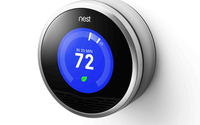 The new marketing pitch for why a consumer
should join the smart home revolution may be as simple as money.
The new marketing pitch for why a consumer
should join the smart home revolution may be as simple as money.
As in saving it, that is.
A new report just out concludes that home automation through the Internet of Things could
reduce home energy consumption by 10%.
Savings would come from better managing household actions, specifically with connected thermostats, window covering controls, circuit-level control, HVAC
zoning and lighting controls.
For example, thermostats could be remotely controlled by smartphone to increase or decrease the temperature while not at home or HVAC zoning control could change
the temperature in rooms not currently occupied and adjust back when they are.
Circuit-level control would allow a homeowner to have devices that draw power when not actively used be powered
off automatically and lighting could be turned on only when a room is occupied.
The report was commissioned by the Consumer Technology Association (CTA), formerly the Consumer Electronics
Association, the group that runs CES in Las Vegas every January. It was conducted by the Fraunhofer Center for Sustainable Energy CSE.
The main motivators to purchase smart home products like
thermostats and light fixtures have been convenience, security and entertainment, according to CTA.
The study found that promoting the energy savings potential to homeowners could increase the
marketability of such products.
It just may take some marketing focused on saving money to kick start the market.
Another new study found that most (72%) of residents in the U.K. are
not interested in buying smart home technologies such as smart heating systems or lighting.
However, that survey of 2,000 households, conducted by PwC, also found that of those who already own
a smart device, 81% notice a positive impact from smart heating.
Additionally, 95% see the benefits from their smart appliances, such as ovens that download recipes.
More than a third
(37%) of consumers are likely to be swayed to adopt smart energy technology by free supplies and installation and 35% by a reduction in energy bills.
On the other hand, only 9% would be moved
in the direction of smart devices by the desire to manage things through an app and even fewer (6%) to keep up with tech-savvy friends and family.
For smart home growth, at least for the
moment, money is in the driver’s seat.